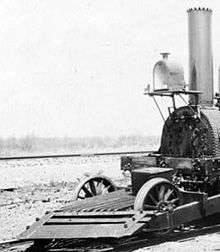Isaac Dripps
Isaac Dripps (April 17, 1810 – December 28, 1892) was an American machinist and inventor. He worked on the locomotive John Bull and built seven locomotives. Dripps was a superintendent and partner of various railroad machinery shops. He has several patents to his name.
Early life
Dripps was born in Belfast, Ireland on April 17, 1810. He came to the United States with his parents when a child. The family settled in Philadelphia.[1][2][3][4]
Career
Dripps became a machinist apprentice to steamboat machinery manufacturer Thomas Holloway of Philadelphia in 1826 at the age of sixteen.[5] He became a foreman there when he was twenty years old in 1830. He was in charge of extensive repairs to the USS Swan in New York harbor in 1831 when he was twenty-one years old.[1]
Dripps then was enticed by Robert Lewis Stevens, president of Camden & Amboy Railroad, to work for them.[4] He was employed there from 1831–1853.[5] He worked on the locomotive "John Bull" during that time.[6] In the fall of 1833 Dripps was made superintendent of the company's railroad machinery. He took charge of the company's shops and built seven locomotives at Hoboken, New Jersey.[1]
Dripps was supervisor of overhauling the steamship "Commodore Stockton" afterwards renamed the "New Jersey" built in England by Captain John Ericsson in 1839. This boat had two screws, revolving in opposite directions to prevent listing of the boat. That function was mechanically complicated and troublesome. Dripps overhauled the boat in 1840.[1] In the process he put in a simple engine and built a six-bladed single propeller screw[1] that drove the boat for over two decades. He is thus credited with designing the propeller for the first commercially successful screw-propelled steamboat.[7]
Dripps was a partner of the Trenton Locomotive & Machine Works at Trenton, New Jersey from 1853 to 1859. [5] In 1859 he was appointed superintendent of machinery of the Pittsburgh, Fort Wayne & Chicago railroad at Fort Wayne, Indiana. He built the railroad repair shops there and for years the state-of-the art shops of America. When the Fort Wayne railroad was leased by the Pennsylvania Railroad Dripps was appointed inspector of all the company shops and machinery. In 1869 Dripps retired.[1]
Family
Dripps married in 1830. From this marriage there was 1 child, William.[5] From 1878 until his death on December 28, 1892, Dripps resided with his son in Philadelphia.[1]
Patents

- Dripps invented the first locomotive cowcatcher[8] which the Camden and Amboy Railroad used in 1833.[9] It was used on the John Bull railroad locomotive.[10]
- US78074A- Railroad car stove for heat, Patent No. 78074, dated May 19, 1868
- US82810A – Improvement in railroad-oar, Patent No. 82810, dated October 6, 1868
- US98675A – Railroad car truck, Patent No. 98675, dated January 11, 1870
- US117753A – Improvement in railway journal-boxes, Patent No. 117753, dated August 8, 1871
- US156455A – Improvement in railway-car trucks, Patent No. 156455, dated November 3, 1874
Legacy
Dripps conducted a series of tests in 1878 with different classes of locomotives on the mountain curves and grades near Renovo, Pennsylvania that resulted in the adoption of the Class R consolidation locomotive as the standard freight engine. Dripps was the first working locomotive engineer, the first railway master mechanic and the first superintendent of machinery of an American railroad.[1]
References
- 1 2 3 4 5 6 7 8 Mechanics 1893, p. 226.
- ↑ Treese 2006, p. 23.
- ↑ White 1979, p. 451.
- 1 2 White 1936, pp. 179–180.
- 1 2 3 4 Marquis 1966, p. 226.
- ↑ "Engraving of the factory of Rogers, Ketchum & Grosvenor, Paterson, N.J., 1832. – Metadata – Metadata". Rutgers University Libraries. 2015. Retrieved September 25, 2015.
- ↑ "Screw propeller model". American on the Move. Smithsonian Institution – National Museum of American History. 2015. Retrieved September 25, 2015.
- ↑ Gross 2002, p. 266.
- ↑ Kane 1997, p. 469.
- ↑ "The Camden & Amboy's John Bull". American-Rails. American-Rails.com. 2015. Retrieved September 25, 2015.
Curiously, workers decided to add affix a cowcatcher to this lead axle as nothing more than an afterthought, a feature that later became quite useful in larger models like the 4-4-0 American to move cows off of the tracks without derailing the train. To add the pilot axle, however, required the removal of the coupling rod between the two main axles. Because of this the John Bull's only powered wheel-set was the rear axle, closest to the control stand although it was still listed as a 2-4-0.
Sources
- Kane, Joseph Nathan (1997). Famous First Facts, Fifth Edition. The H. W. Wilson Company. ISBN 0-8242-0930-3.
The first locomotive cowcatcher was invented by Isaac Dripps and used in 1833 on the Camden and Amboy Railroad between Bordentown and Hightstown, New Jersey. It consisted originally of a small attachment on two wheels with projecting points, but since the prongs impaled animals, it was replaced by a heavy bar set at right angles to the rails.
- Gross, Ernie (1 January 2002). Advances and Innovations in American Daily Life, 1600s–1930s. McFarland. ISBN 978-0-7864-1248-8.
- Marquis (1966). Who's Who in American History. Marquis.
- Mechanics (1893). Report of the Proceedings of the ... Annual Convention of the American Railway Master Mechanics' Association.
- Treese, Lorett (2006). Railroads of New Jersey: Fragments of the Past in the Garden State Landscape. Stackpole Books. ISBN 978-0-8117-3260-4.
- White, James T. (1936). National Cyclopedia of American Biography. James T. White & Company.
- White, John H. (1979). A History of the American Locomotive: Its Development, 1830–1880. Courier Corporation. ISBN 978-0-486-23818-0.